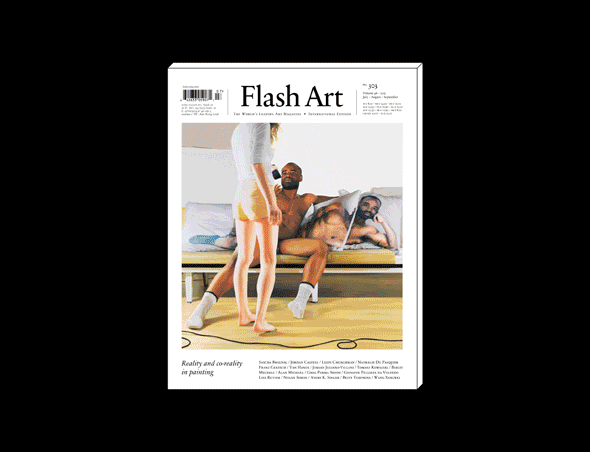July–August–September 2015
We are pleased to announce that the July–August–September issue of Flash Art International is out now.
In this issue, we delve into the appropriationist, realist and photorealist tendencies that characterize the practices of several emerging figurative painters. In 1972, Harald Szeemann’s dOCUMENTA 5 challenged the mass media’s agency over factual representation. Titled Questioning Reality—Pictorial Worlds Today, the exhibition provided what is perhaps the most exhaustive account of pictorial photorealism. Today, the pervasiveness of the Internet and the progressive erosion of the “concrete” through the emergence of virtual realities suggests a theoretical update to the notion of realism in painting. These manifold realities animate the work of painters, providing subject matter but also informing their pictorial language in terms of technique and style. The “pictorial worlds” narrated by Szeemann have developed into a “co-reality” in which the real and the virtual co-exist within and upon the painting itself. The “co-reality” of the painting suggests that the question of reality in contemporary art production is no longer limited to the depiction of everyday existence, but necessarily deals with strategies of image-making on the canvas.
In four roundtables—involving painters Sascha Braunig, Jordan Casteel, Leidy Churchman, Van Hanos, Jamian Juliano-Villani, Tomasz Kowalski, Birgit Megerle, Alan Michael, Greg Parma Smith, Nolan Simon and Avery K. Singer and hosted by Lauren Cornell, Michele D’Aurizio, Eli Diner and Martha Kirszenbaum—we discuss different levels of cohesion between the imaginary and the actuality of painting. We raise questions related to subject matter and contemporary image culture; labor, technique and connoisseurship; the “gendered” gaze; and, finally, the role of technology in “producing” reality. Alongside the roundtables, we envision an alternative history of photorealism through a series of essays examining individual paintings by lesser-known figures associated with this tendency. Here, Marco Tagliafierro, Eva Kenny, Eric Golo Stone, Mohammad Salemy, William J. Simmons and Philip Tinari explore works by, respectively, Nathalie Du Pasquier, Franz Gertsch, Giuseppe Pellizza da Volpedo, Lisa Ruyter, Betty Tompkins and Wang Xingwei. These painters, each in their own specific way, address photorealist conventions while inviting a reconsideration of the historical premises of the genre.
Also, in this issue:
Tom’s House, a visual project by Marie Angeletti.
In Arena:
Ralph Rugoff on the 13th Biennale de Lyon; Max Schumann on Printed Matter, New York; Abdelmonem Alserkal on the Alserkal Avenue, Dubai; Ccru‘s Writings 1997–2003; Eva Presenhuber, Zurich; Susan Cianciolo, New York; Night Club, Chicago; Matías Piñeiro, Buenos Aires; Alessio Antoniolli on Gasworks, London; Leo Xu, Shanghai; Bart De Baere, Defne Ayas and Nicolaus Schafhausen on the 6th Moscow Biennale; Alex Waterman and Will Holder‘s Yes, But Is It Edible?
And in Reviews:
“All the World’s Futures” and National Pavilions at the 56th Venice Biennale; Jutta Koether at Bortolami, New York; Rey Akdogan at Miguel Abreu, New York; Loretta Fahrenholz at Midway, Minneapolis; Emanuel Rossetti at Karma International, Los Angeles; Peter Saul at David Kordansky, Los Angeles; Viola Yeşiltaç at Boatos Fine Arts, Sao Paulo; Hilary Lloyd at Sadie Coles HQ, London; Bojan Šarčević at BQ, Berlin; Cindie Cheung at Flotowstrasse 11, Berlin; Love for Three Oranges at Gladstone, Brussels; Marcel Broodthaers at La Monnaie, Paris; Le Corbusier at Centre Pompidou, Paris; Vaclav Pozarek at Francesca Pia, Zürich; Lara Favaretto at MAXXI, Rome; Dóra Maurer at Vintage Gallery, Budapest; Garage Museum of Contemporary Art, Moscow; Susanta Mandal at Vadehra Art Gallery, New Delhi; Liu Shiyuan at White Space, Beijing; Leung Chi Wo at OCAT, Shenzhen.

